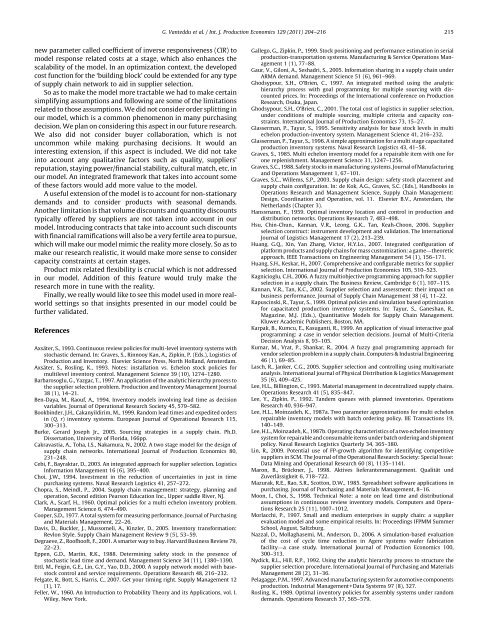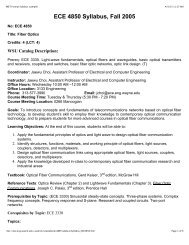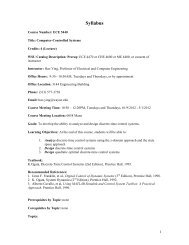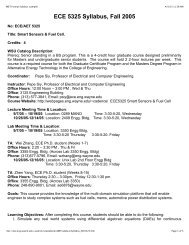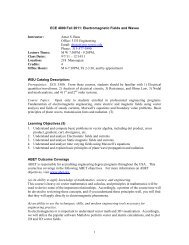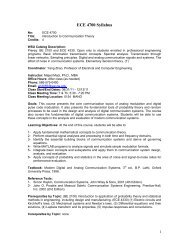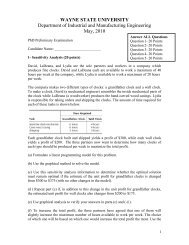Supply chain focus dependent supplier selection problem
Supply chain focus dependent supplier selection problem
Supply chain focus dependent supplier selection problem
You also want an ePaper? Increase the reach of your titles
YUMPU automatically turns print PDFs into web optimized ePapers that Google loves.
G. Vanteddu et al. / Int. J. Production Economics 129 (2011) 204–216 215new parameter called coefficient of inverse responsiveness (CIR) tomodel response related costs at a stage, which also enhances thescalability of the model. In an optimization context, the developedcost function for the ‘building block’ could be extended for any typeof supply <strong>chain</strong> network to aid in <strong>supplier</strong> <strong>selection</strong>.So as to make the model more tractable we had to make certainsimplifying assumptions and following are some of the limitationsrelated to those assumptions. We did not consider order splitting inour model, which is a common phenomenon in many purchasingdecision. We plan on considering this aspect in our future research.We also did not consider buyer collaboration, which is notuncommon while making purchasing decisions. It would aninteresting extension, if this aspect is included. We did not takeinto account any qualitative factors such as quality, <strong>supplier</strong>s’reputation, staying power/financial stability, cultural match, etc. inour model. An integrated framework that takes into account someof these factors would add more value to the model.A useful extension of the model is to account for non-stationarydemands and to consider products with seasonal demands.Another limitation is that volume discounts and quantity discountstypically offered by <strong>supplier</strong>s are not taken into account in ourmodel. Introducing contracts that take into account such discountswith financial ramifications will also be a very fertile area to pursue,which will make our model mimic the reality more closely. So as tomake our research realistic, it would make more sense to considercapacity constraints at certain stages.Product mix related flexibility is crucial which is not addressedin our model. Addition of this feature would truly make theresearch more in tune with the reality.Finally, we really would like to see this model used in more realworldsettings so that insights presented in our model could befurther validated.ReferencesAxsäter, S., 1993. Continuous review policies for multi-level inventory systems withstochastic demand. In: Graves, S., Rinnooy Kan, A., Zipkin, P. (Eds.), Logistics ofProduction and Inventory. Elsevier Science Press, North Holland, Amsterdam.Axsäter, S., Rosling, K., 1993. Notes: installation vs. Echelon stock policies formultilevel inventory control. Management Science 39 (10), 1274–1280.Barbarosoglu, G., Yazgac, T., 1997. An application of the analytic hierarchy process tothe <strong>supplier</strong> <strong>selection</strong> <strong>problem</strong>. Production and Inventory Management Journal38 (1), 14–21.Ben-Daya, M., Raouf, A., 1994. Inventory models involving lead time as decisionvariables. Journal of Operational Research Society 45, 579–582.Bookbinder, J.H., Cakanyildirim, M., 1999. Random lead times and expedited ordersin (Q, r) inventory systems. European Journal of Operational Research 115,300–313.Burke, Gerard Joseph Jr., 2005. Sourcing strategies in a supply <strong>chain</strong>. Ph.D.Dissertation, University of Florida, 166pp.Cakravastia, A., Toha, I.S., Nakamura, N., 2002. A two stage model for the design ofsupply <strong>chain</strong> networks. International Journal of Production Economics 80,231–248.Cebi, F., Bayraktar, D., 2003. An integrated approach for <strong>supplier</strong> <strong>selection</strong>. LogisticsInformation Management 16 (6), 395–400.Choi, J.W., 1994. Investment in the reduction of uncertainties in just in timepurchasing systems. Naval Research Logistics 41, 257–272.Chopra, S., Meindl, P., 2004. <strong>Supply</strong> <strong>chain</strong> management: strategy, planning andoperation, Second edition Pearson Education Inc., Upper saddle River, NJ.Clark, A., Scarf, H., 1960. Optimal policies for a multi echelon inventory <strong>problem</strong>.Management Science 6, 474–490.Cooper, S.D., 1977. A total system for measuring performance. Journal of Purchasingand Materials Management, 22–26.Davis, D., Buckler, J., Mussomeli, A., Kinzler, D., 2005. Inventory transformation:Revlon Style. <strong>Supply</strong> Chain Management Review 9 (5), 53–59.Degraeve, Z., Roofhooft, F., 2001. A smarter way to buy. Harvard Business Review 79,22–23.Eppen, G.D., Martin, R.K., 1988. Determining safety stock in the presence ofstochastic lead time and demand. Management Science 34 (11), 1380–1390.Ettl, M., Feigin, G.E., Lin, G.Y., Yao, D.D., 2000. A supply network model with basestockcontrol and service requirements. Operations Research 48, 216–232.Felgate, R., Bott, S., Harris, C., 2007. Get your timing right. <strong>Supply</strong> Management 12(1), 17.Feller, W., 1960. An Introduction to Probability Theory and its Applications, vol. I.Wiley, New York.Gallego, G., Zipkin, P., 1999. Stock positioning and performance estimation in serialproduction-transportation systems. Manufacturing & Service Operations Management1 (1), 77–88.Gaur, V., Giloni, A., Seshadri, S., 2005. Information sharing in a supply <strong>chain</strong> underARMA demand. Management Science 51 (6), 961–969.Ghodsypour, S.H., O’Brien, C., 1997. An integrated method using the analytichierarchy process with goal programming for multiple sourcing with discountedprices. In: Proceedings of the International conference on ProductionResearch, Osaka, Japan.Ghodsypour, S.H., O’Brien, C., 2001. The total cost of logistics in <strong>supplier</strong> <strong>selection</strong>,under conditions of multiple sourcing, multiple criteria and capacity constraints.International Journal of Production Economics 73, 15–27.Glasserman, P., Tayur, S., 1995. Sensitivity analysis for base stock levels in multiechelon production-inventory system. Management Science 41, 216–232.Glasserman, P., Tayur, S., 1996. A simple approximation for a multi stage capacitatedproduction inventory systems. Naval Research Logistics 43, 41–58.Graves, S., 1985. Multi echelon inventory model for a repairable item with one forone replenishment. Management Science 31, 1247–1256.Graves, S.C., 1988. Safety stocks in manufacturing systems. Journal of Manufacturingand Operations Management 1, 67–101.Graves, S.C., Willems, S.P., 2003. <strong>Supply</strong> <strong>chain</strong> design: safety stock placement andsupply <strong>chain</strong> configuration. In: de Kok, A.G., Graves, S.C. (Eds.), Handbooks inOperations Research and Management Science, <strong>Supply</strong> Chain Management:Design, Coordination and Operation, vol. 11. Elsevier B.V., Amsterdam, theNetherlands (Chapter 3).Hanssmann, F., 1959. Optimal inventory location and control in production anddistribution networks. Operations Research 7, 483–498.Hsu, Chin-Chun., Kannan, V.R., Leong, G.K., Tan, Keah-Choon, 2006. Supplier<strong>selection</strong> construct: instrument development and validation. The InternationalJournal of Logistics Management 17 (2), 213–239.Huang, G.Q., Xin, Yan Zhang, Victor, H.Y.Lo., 2007. Integrated configuration ofplatform products and supply <strong>chain</strong>s for mass customization: a game—theoreticapproach. IEEE Transactions on Engineering Management 54 (1), 156–171.Huang, S.H., Keskar, H., 2007. Comprehensive and configurable metrics for <strong>supplier</strong><strong>selection</strong>. International Journal of Production Economics 105, 510–523.Kagnicioglu, C.H., 2006. A fuzzy multiobjective programming approach for <strong>supplier</strong><strong>selection</strong> in a supply <strong>chain</strong>. The Business Review, Cambridge 6 (1), 107–115.Kannan, V.R., Tan, K.C., 2002. Supplier <strong>selection</strong> and assessment: their impact onbusiness performance. Journal of <strong>Supply</strong> Chain Management 38 (4), 11–22.Kapuscinski, R., Tayur, S., 1999. Optimal policies and simulation based optimizationfor capacitated production inventory systems. In: Tayur, S., Ganeshan, R.,Magazine, M.J. (Eds.), Quantitative Models for <strong>Supply</strong> Chain Management.Kluwer Academic Publishers, Boston, MA.Karpak, B., Kumcu, E., Kasuganti, R., 1999. An application of visual interactive goalprogramming: a case in vendor <strong>selection</strong> decisions. Journal of Multi-CriteriaDecision Analysis 8, 93–105.Kumar, M., Vrat, P., Shankar, R., 2004. A fuzzy goal programming approach forvendor <strong>selection</strong> <strong>problem</strong> in a supply <strong>chain</strong>. Computers & Industrial Engineering46 (1), 69–85.Lasch, R., Janker, C.G., 2005. Supplier <strong>selection</strong> and controlling using multivariateanalysis. International journal of Physical Distribution & Logistics Management35 (6), 409–425.Lee, H.L., Billington, C., 1993. Material management in decentralized supply <strong>chain</strong>s.Operations Research 41 (5), 835–847.Lee, Y., Zipkin, P., 1992. Tandem queues with planned inventories. OperationsResearch 40, 936–947.Lee, H.L., Moinzadeh, K., 1987a. Two parameter approximations for multi echelonrepairable inventory models with batch ordering policy. IIE Transactions 19,140–149.Lee, H.L., Moinzadeh, K., 1987b. Operating characteristics of a two echelon inventorysystem for repairable and consumable items under batch ordering and shipmentpolicy. Naval Research Logistics Quarterly 34, 365–380.Lin, R., 2009. Potential use of FP-growth algorithm for identifying competitive<strong>supplier</strong>s in SCM. The Journal of the Operational Research Society: Special Issue:Data Mining and Operational Research 60 (8), 1135–1141.Maron, B., Brückner, J., 1998. Aktives lieferantenmanagement. Qualität undZuverlässigkeit 6, 718–722.Mazurak, R.E., Rao, S.R., Scotton, D.W., 1985. Spreadsheet software applications inpurchasing. Journal of Purchasing and Materials Management, 8–16.Moon, I., Choi, S., 1998. Technical Note: a note on lead time and distributionalassumptions in continuous review inventory models. Computers and OperationsResearch 25 (11), 1007–1012.Morlacchi, P., 1997. Small and medium enterprises in supply <strong>chain</strong>: a <strong>supplier</strong>evaluation model and some empirical results. In: Proceedings IFPMM SummerSchool, August, Saltzburg.Nazzal, D., Mollaghasemi, M., Anderson, D., 2006. A simulation-based evaluationof the cost of cycle time reduction in Agere systems wafer fabricationfacility—a case study. International Journal of Production Economics 100,300–313.Nydick, R.L., Hill, R.P., 1992. Using the analytic hierarchy process to structure the<strong>supplier</strong> <strong>selection</strong> procedure. International Journal of Purchasing and MaterialsManagement 28 (2), 31–36.Pelagagge, P.M., 1997. Advanced manufacturing system for automotive componentsproduction. Industrial Management+Data Systems 97 (8), 327.Rosling, K., 1989. Optimal inventory policies for assembly systems under randomdemands. Operations Research 37, 565–579.


